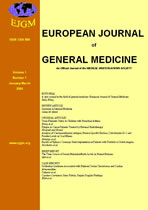
|
European Journal of General Medicine
Medical Investigations Society
ISSN: 1304-3897
Vol. 6, No. 2, 2009, pp. 108-115
|
 Bioline Code: gm09024
Bioline Code: gm09024
Full paper language: English
Document type: Research Article
Document available free of charge
|
|
|
European Journal of General Medicine, Vol. 6, No. 2, 2009, pp. 108-115
| en |
Amniotic Fluid Embolism
Toy, Dr. Harun
Abstract
Amniotic fluid embolism (AFE) is a catastrophic syndrome occurring
during labor and delivery or immediately postpartum. Amniotic
fluid embolism is an important cause of maternal deaths in developed
countries. It has high morbidity and mortality rate. The
associated mortality and morbidity have decreased dramatically in
recent times, such that recent reported maternal mortality is now
in the order of 16%. The true incidence is unclear because this
syndrome is difficult to identify and the diagnosis remains one
of exclusion, with possible under-reporting of nonfatal cases. The
pathophysiology of AFE remains unclear. Amniotic fluid embolism
occurs when there is a breach in the barrier between the maternal
circulation and amniotic fluid. Two separate life-threatening processes
seem to occur either simultaneously or in sequence, namely,
cardiorespiratory collapse and coagulopathy. The symptoms of AFE
commonly occur during labor and delivery or in the immediate
postpartum period. Most cases (80%) occur during labor, but it
can occur either before labor (20%) or after delivery. About 25%
of patients will die within 1 hour of onset. The classic clinical
presentation of AFE is that of sudden onset of dyspnea, respiratory
failure and hypotension followed by cardiovascular collapse,
disseminated intravascular coagulation and death. AFE is poorly
understood and diagnosed largely by exclusion. Presently, the AFE
diagnosis is not based on any clinical or laboratory finding. The
treatment is still not causative but supportive and focuses initially
on rapid maternal cardiopulmonary stabilization. The most
important goal of therapy is to prevent additional hypoxia and
subsequent end-organ failure. The prognosis and mortality of AFE
have improved significantly with early diagnosis of AFE and prompt
and early resuscitative measures.
Keywords
Amniotic fluid embolism, cardiorespiratory collapse, coagulopathy, disseminated intravascular coagulation
|
| |
© Copyright 2009 - Medical Investigations Society
Alternative site location: http://www.ejgm.org
|
|
